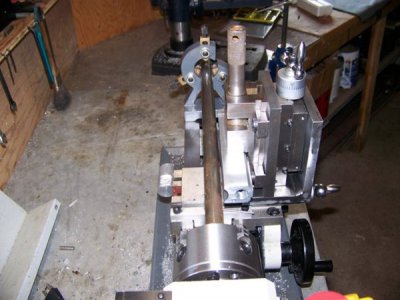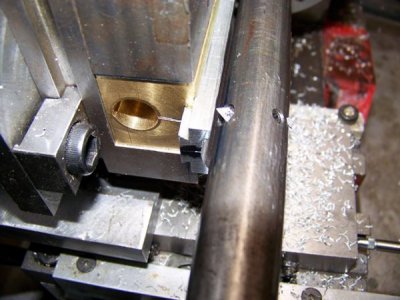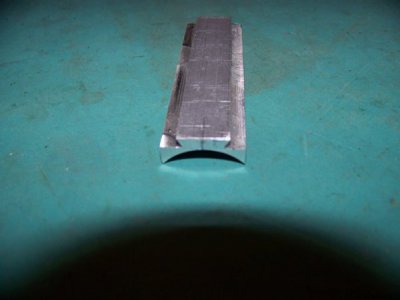...at least I think that's what you would call it?
Hi guys, I need some advice from any/all more experienced than me on a setup I’m thinking of trying. You say there is no such thing as a stupid question…let’s see if you still think that after this episode.
I only have a 7x12 mini lathe w/milling attachment so keep that in mind, too (i.e- very limited work space).
Problem:
I need to bore a .469” diameter thru-hole x 6.5” long in some 1” aluminum hex bar (6061) for an airgun breech. I’ve made a couple breeches before with 1”x 1.25” 6061 flat bar with 1/2” bore, but always seem to struggle getting a hole bored from one end to the other & have it perfectly concentric. Usually chuck the bar stock in my 4-jaw, opposite end in a cat’s head & drill halfway or better with a jobber length drill. Then flip piece end for end & repeat…& hope the 2 holes line up perfectly (hasn’t yet). Reaming after makes for a smooth bore, but doesn’t really help concentricity much if the 2 holes are out of whack to begin with.
Proposed solution:
I made an adjustable radius-cutting tool a while back to cut the profile on the bottom of a breech to match whatever size tube it will be mated to (mostly .875” o/d ) . The “tool” is simply just an 18” long piece of 3/4” o/d CR1018 bar supported in steady rest (15” total workspace) with a chunk of 1/4” drill bit shank ground for the cutter at mid-span, held in place with a 8-32 set screw. Works awesome & much cheaper/quicker than buying a boatload of ball-nose end mills.
Cutter orientation for breech:

Cutting .968” diameter radius with same tool for a dovetail scope rail:


I was thinking that this time around I might try making another tool like above, but this time using O1 drill rod & only .430” o/d with 5/32 drill shank for cutter held in place with a 6-32 set screw. I would still initially drill (under size) halfway from each end with .453” (29/64”) stub/jobber drills, then slide the hex onto cutter bar, mount assembly in chuck/steady rest with hex held in milling attachment (indicated to ensure it’s centered, of course). Then I would be able to make my first pass @ say .455” to clean up bore & ensure things are squared up & running true, then re-adjust cutter to make a second pass on size @ .469” (.007” DOC). Could even split that into 2 passes if need be to reduce flex (.004” then .003” DOC). Heck, I’ll even make 7 passes @ .001” DOC if that’s what it takes.
Do you think this is even feasible, or am I a fool for even thinking about it?
My gut feeling is that .430” o/d @ 14-15” clear span between chuck/steady rest might be like using a rope or piece of spaghetti. Then again, maybe it will work. Regardless, unless I’m told it absolutely won’t work (quite possible), I may give it a whirl just to settle my curiosity….wouldn’t be the first (or last) time I made a bad decision. Just thought I would ask here first before marching on.
Thanks in advance for any insight you can offer!
Hi guys, I need some advice from any/all more experienced than me on a setup I’m thinking of trying. You say there is no such thing as a stupid question…let’s see if you still think that after this episode.
I only have a 7x12 mini lathe w/milling attachment so keep that in mind, too (i.e- very limited work space).
Problem:
I need to bore a .469” diameter thru-hole x 6.5” long in some 1” aluminum hex bar (6061) for an airgun breech. I’ve made a couple breeches before with 1”x 1.25” 6061 flat bar with 1/2” bore, but always seem to struggle getting a hole bored from one end to the other & have it perfectly concentric. Usually chuck the bar stock in my 4-jaw, opposite end in a cat’s head & drill halfway or better with a jobber length drill. Then flip piece end for end & repeat…& hope the 2 holes line up perfectly (hasn’t yet). Reaming after makes for a smooth bore, but doesn’t really help concentricity much if the 2 holes are out of whack to begin with.
Proposed solution:
I made an adjustable radius-cutting tool a while back to cut the profile on the bottom of a breech to match whatever size tube it will be mated to (mostly .875” o/d ) . The “tool” is simply just an 18” long piece of 3/4” o/d CR1018 bar supported in steady rest (15” total workspace) with a chunk of 1/4” drill bit shank ground for the cutter at mid-span, held in place with a 8-32 set screw. Works awesome & much cheaper/quicker than buying a boatload of ball-nose end mills.
Cutter orientation for breech:

Cutting .968” diameter radius with same tool for a dovetail scope rail:


I was thinking that this time around I might try making another tool like above, but this time using O1 drill rod & only .430” o/d with 5/32 drill shank for cutter held in place with a 6-32 set screw. I would still initially drill (under size) halfway from each end with .453” (29/64”) stub/jobber drills, then slide the hex onto cutter bar, mount assembly in chuck/steady rest with hex held in milling attachment (indicated to ensure it’s centered, of course). Then I would be able to make my first pass @ say .455” to clean up bore & ensure things are squared up & running true, then re-adjust cutter to make a second pass on size @ .469” (.007” DOC). Could even split that into 2 passes if need be to reduce flex (.004” then .003” DOC). Heck, I’ll even make 7 passes @ .001” DOC if that’s what it takes.
Do you think this is even feasible, or am I a fool for even thinking about it?

My gut feeling is that .430” o/d @ 14-15” clear span between chuck/steady rest might be like using a rope or piece of spaghetti. Then again, maybe it will work. Regardless, unless I’m told it absolutely won’t work (quite possible), I may give it a whirl just to settle my curiosity….wouldn’t be the first (or last) time I made a bad decision. Just thought I would ask here first before marching on.
Thanks in advance for any insight you can offer!

 .
.